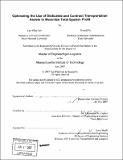| dc.contributor.advisor | Christopher G. Caplice. | en_US |
| dc.contributor.author | Lee, Tae Whee | en_US |
| dc.contributor.author | Po, Ronald | en_US |
| dc.contributor.other | Massachusetts Institute of Technology. Engineering Systems Division. | en_US |
| dc.date.accessioned | 2008-02-04T20:48:07Z | |
| dc.date.available | 2008-02-04T20:48:07Z | |
| dc.date.copyright | 2007 | en_US |
| dc.date.issued | 2007 | en_US |
| dc.identifier.uri | http://hdl.handle.net/1721.1/40117 | |
| dc.description | Thesis (M. Eng. in Logistics)--Massachusetts Institute of Technology, Engineering Systems Division, 2007. | en_US |
| dc.description | Includes bibliographical references (leaf 100). | en_US |
| dc.description.abstract | Each week, FruitCo (FC) ships over a thousand containers of fresh fruits to its various port facilities in the US. Once the containers arrive at the port, approximately half of these containers are received by customers while the remaining half is handled by FC and delivered to customers by either a dedicated or contract carrier. For each containers delivered by FC, heuristics and cost-analysis are used to make the carrier decision. Like other shippers with multiple carrier options, FC needs to both maximize profit and preserve service quality. FC's existing decision framework focuses on fronthaul profit for each delivery while its heuristics do not reflect specific service or cost strategies. Additionally, the existence of backhaul revenue, late returns of containers, limits on containers and dedicated drivers, and a variable ship arrival and departure schedule meant that existing decisions were limited in scope and rarely maximized profit for FC's delivery operations (part of port operations) as a whole. In our thesis, we created a new decision framework to maximize FC's container operations at one of its ports, Port A (PA). We grouped containers from a single ship as an interdependent set of deliveries, forming a single cycle. | en_US |
| dc.description.abstract | (cont.) Accounting for various constraints and potential backhauls, our optimization maximized the profit of a single cycle. The decisions made by the optimization achieved a weekly profit improvement of over 30% without affecting service quality. Supplementing our model, we conducted a sensitivity analysis on the number of containers and dedicated drivers to provide FC insight into its optimal asset size at PA. | en_US |
| dc.description.statementofresponsibility | by Tae Whee Lee [and] Ronald Po. | en_US |
| dc.format.extent | 100, [24] leaves | en_US |
| dc.language.iso | eng | en_US |
| dc.publisher | Massachusetts Institute of Technology | en_US |
| dc.rights | M.I.T. theses are protected by copyright. They may be viewed from this source for any purpose, but reproduction or distribution in any format is prohibited without written permission. See provided URL for inquiries about permission. | en_US |
| dc.rights.uri | http://dspace.mit.edu/handle/1721.1/7582 | |
| dc.subject | Engineering Systems Division. | en_US |
| dc.title | Optimizing the use of dedicated and contract transportation assets to maximize total system profit | en_US |
| dc.type | Thesis | en_US |
| dc.description.degree | M.Eng.in Logistics | en_US |
| dc.contributor.department | Massachusetts Institute of Technology. Engineering Systems Division | |
| dc.identifier.oclc | 187079634 | en_US |
